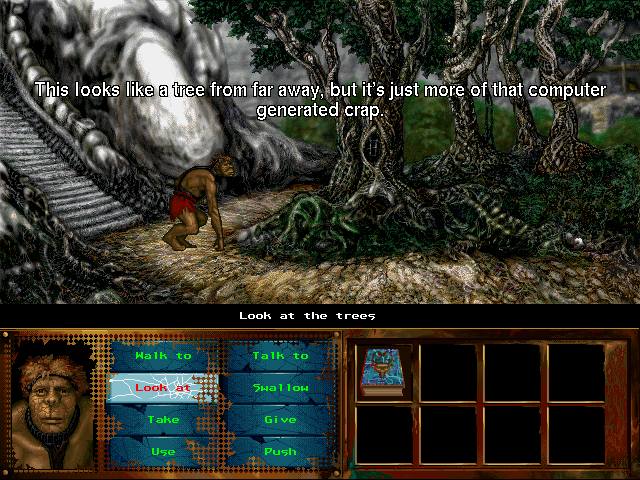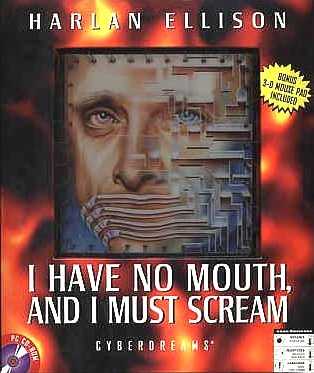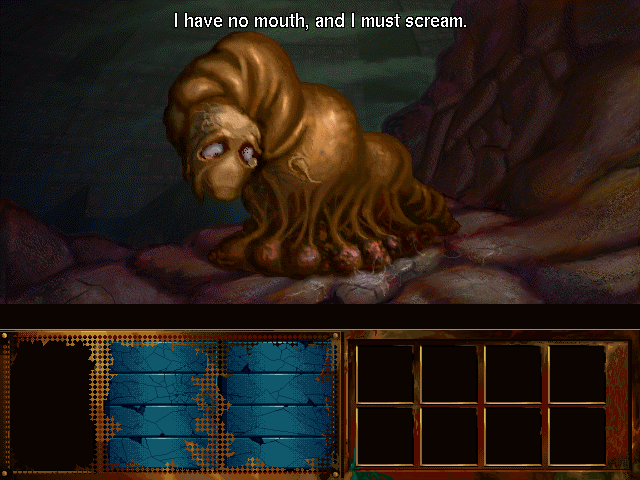While checking the comments on my previous day's peregrinations across the twisted mindscape of Harlan Ellison, the cynical author behind the post-apocalyptic sci-fi novella and video game adaptation of I Have No Mouth, and I Must Scream, I took in a few corrections/elucidations and came upon a realization for why I wanted to switch things up for May Madness this year: Each prior season of May Madness regularly followed a process wherein I would play the first few hours of a game and relay my initial impressions. However, this meant that I could never really achieve a comprehensive understanding of the game - the full breadth of its ideas and intent. Rather, all I had from that short trial period were educated guesses as to where they might go.
That's not just because I was unable to see the game's conclusion in that short amount of time, either; the way I approach games is by ensuring that the first playthrough is also my first real exposure to that game. It's why I fervently avoid pre-release hype, trailers, Wikipedia summaries, analyses and reviews of games before I have the chance to play them myself (should it interest me, at least: I've no issue with spoiling terrible games for myself). In a sense, that's partly what initially drew me to Giant Bomb, after spending decades avoiding the games press: much of its content is geared towards producing introductory snippets that tell me everything I want to know about a game, without divulging too much information about how it actually ticks or how it will eventually pan out. It saves all the fun stuff for the viewer to discover in their own time: the part where you can really get down and dirty with a game beyond those few first minutes wandering around in confusion and getting to grips with the UI.
There's value in early impressions, is the TL;DR of all this, but perhaps more valuable still is having that full picture to expound on. It's why I still firmly believe in the importance of reviews or, as I suspect will be the new norm in the years to come, replacements such as "Spoilercasts" and "Encyclopedia Bombastica"-type features: in-depth, comprehensive explications on the function, the story and the appeal of individual games once the reviewer has spent a sufficient length of time with them, exploring all (or close to all) of its content or by reaching the conclusion of its story. (Depending on the game, any or all of those might apply.) That's the reason I'm doing May Mastery this year: I want to provide both those early, unproven thoughts and something a little more thorough after I've beaten the game and can research it without the fear that I'm somehow despoiling my first playthrough.
With all that said, let's get to the conclusion of this I Have No Mouth, and I Must Scream analysis before I completely disappear up my own ass:
I Have No Mouth, and I Must Scream
I talked about how Gorrister's campaign opened a can of worms by introducing the idea of fail states to the game's palette, and Benny's goes another step further by introducing the game's rather lackadaisical approach to quality control. While I Have No Mouth, and I Must Scream is fascinating and well-written from a narrative standpoint, it does suffer from more than its fair share of bugs. I ran into a problem with Benny's campaign where Benny and the cursor would completely disappear after reloading a save, which made progress impossible. Later on, I discovered that the solution to a section that stymied me for a good part of an hour required that a specific character would eventually depart its location and leave an item untended that I had to steal, except the character stayed put the whole time. Whatever trigger I needed to hit to shift them did not take, and I was left with a stalemate situation of which I had no cognizance. It's one thing to be at the mercy of mercurial puzzle design that can kill (or reset one's progress, in this case) the player character, but another entirely to betray the player's intrinsic trust that the game is fully operational and working by its own internal logic that is left to that player to fathom.

But really, instances like those are sporadic and the game worked like it was supposed to most of the time. Learning yesterday that the spiritual health of a character really only determines how many mistakes they can afford to make in the final scenario, there is still something to the idea of completing each scenario "perfectly": if the player performs no ethical errors, doesn't consult the hint system and completes various hidden objectives that demonstrate the character's virtues, the character ends up with a pure white spiritual barometer, i.e. the best case scenario. In this regard, IHNMaIMS reminded me of the underrated Wii game Zack and Wiki: Quest for Barbaros' Treasure. That game also featured a system that judged not only a player's puzzle perspicacity but also their efficiency: by completing every part of the overall puzzle in the right order without errors, the player would receive a higher score. Of course, you'd need to be familiar with the puzzle already to achieve an ideal completion state, so it added an element of replayability often absent within the adventure/puzzle game genre. While you don't need to complete each of IHNMaIMS's scenarios perfectly to get a decent shot at one of the better endings, it does introduce an enticing prospect for players of a more perfectionist bent, not unlike the old point systems in text adventures and Sierra point-n-clicks.
Once again, each of the three remaining scenarios were custom-built to maximize the psychological torment of their particular victims. Benny, an ape-like creature that was once a ruthless military commander (apparently one of the bigger changes from the books, where he was a brilliant gay scientist) before AM modified him, is dropped into a pre-industrial cave-dwelling society with his consciousness intact but still limited by his useless, crippled limbs. He relied on the kindness of strangers, despite not having the most enlightened view of developing world populations as a veteran of the Vietnam War, and eventually learned to embrace compassion and empathy. There's not really a whole lot to this scenario, beyond the aforementioned semi-game-breaking bugs, but it does involve some interesting art design: the caves (and those that live in them) are all mechanical constructs built by AM for his little game, and Benny's near-starving state often lead to him trying to eat the food and flora despite the fact that they're all made of wires and electronics. AM's certainly not the nicest caretaker.
Nimdok's is a little more interesting, though at the same time entirely too on-the-nose. Given his advanced age, labcoat and German accent, it's not a stretch to assume that he's some sort of ex-Nazi doctor that was hiding out in South America before AM found him prior to wiping out the rest of mankind. His scenario very much plays on a specific time and place from his past, rather than the more allegorical scenarios of the other survivors. Either due to his senility or denial, he cannot face the victims of his Dr. Mengele-style experiments (the Nazi Angel of Death himself actually shows up, as if we needed to make the parallel more transparent), and instead goes about helping the prisoners in whatever small ways he can to amend for the hundreds of medical atrocities he has performed. The scenario is built to reflect the end of the war in 1945, when Nimdok and the other Nazis are finally deposed and are forced into hiding: this year is important to AM as well, as it lead to the discovery of all the Nazi science experiments and research for which Nimdok had been responsible, which in turn were used by AM to create most of these scenarios.
With the handsome and well-educated grifter Ted, the game takes something of a more traditional angle. Really, it goes full King's Quest, dropping Ted in a medieval castle and having him solve a group of puzzles involving magic mirrors, witches, demons, angels and a fair damsel (who resembles Ellen, possibly hinting at an abandoned romantic sub-plot between the two). There is also an ever-present threat in the guise of a pack of hungry dire wolves circling the castle: I discovered a way to bar the front door of the castle mostly by accident, so I am left wondering what would've happened if I'd ignored that problem for too long. This part of the game felt a lot less interesting due to its similarities with the aforementioned King's Quest and other generic fantasy settings, though I did like Ted's VA's Owen Wilson-esque Californian inflection. Watching him fumble around a gothic castle full of horrors reminded me of Keanu Reeves's terrible miscasting (and worse accent) in 1992's Bram Stoker's Dracula. (And don't tell me that calling the Californian guy Ted wasn't a deliberate Reeves reference.)

It's the finale of the game that I found the most fascinating part of the whole shebang. Given that the finale only becomes accessible after the rest of the game has been completed, and thus is filled with spoilers, here's a block for you all:
Overall, IHNMaIMS gives me a vibe not unlike Troika's Vampire: The Masquerade: Bloodlines. I was probably a little too harsh on that vampire RPG when I reviewed it, because while it barely works as an action video game it certainly had a lot of intelligence and attention to detail behind its characterizations and narrative elements. It felt like a deeply flawed game that would be very easy to fall in love with, because of how distinctive it was and how little it talked down to its audience. Such games are a rare commodity, and it's worth putting up with a few mechanical snafus to appreciate that core. The same is true with IHNMaIMS I feel, with its ugly (though deliberately so to some extent, and certainly interesting) graphics and its weird bugs and its obtuse mechanics and its outmoded fail state situations. I can't say that there are too many adventure games with its ideas or sense of scope or pitch-black personality, and having the original author step in and adapt the game really lends it an authentic literary edge that is usually the domain of those Legend Entertainment games I covered a while back (which have a lot in common with IHNMaIMS I am now realizing) or the Discworld games.
I Have No Mouth, and I Must Scream is not a perfect adventure game, but it's one of those thematically-atypical titles ideal for aficionados of the adventure game genre (or just of story-driven games in general) looking for something a bit (or a lot) different.


Log in to comment